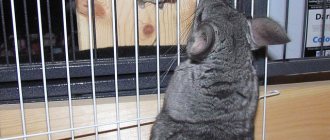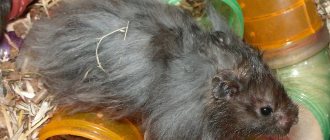The little Djungarian hamster has an extraordinary appearance that will not leave anyone indifferent. True, in a new place he usually categorically refuses to make contact with a person and shows dissatisfaction and fear with a loud squeak.
To accustom a dzhungarik to your hands, it is important to know the main stages of the process, follow the recommendations of experts, and also understand the reasons for possible failures.
Hamster - gray barrel
Let's talk a little about Djungarian hamsters. These rodents, despite their small size, are very interesting creatures. And it doesn’t matter that the hamster weighs less than 50 grams and is not 10 cm tall—a brave and proud heart beats in his hamster chest. It will take time to tame the dwarf.
Hamsters of this breed are strikingly different from the representatives of the Syrian hamster delegation. Small, chipmunk-like in color, gray-brown, with dark stripes on the back, large round eyes and neat ears. But you should not draw the conclusion, looking at the appearance of your pet, that this is a cute and harmless baby. Nothing like that, the Dzungari are obstinate! And the teeth, sharp as needles, have not been canceled. In addition, dzhungarikas are mobile, so they need a spacious cage with a wheel inside. During the night, a baby can run up to 40 km.
Caring for a Syrian hamster at home
“Syrians” become unpretentious animals at home. All they need is a nutritious diet and constant care. Taking care of Syrian animals is quite simple. The main responsibilities of the owner: clean the cage in a timely manner, supply clean drinking water and food once a day. Sometimes an animal can be let out of its house to run around the apartment, but only if it is accustomed to being handled and is not afraid of people. If you follow all the rules, your pet will not cause much trouble.
What to feed a hamster?
Nutrition is the main basis for caring for animals. The diet should be fortified and complete. The Syrian hamster can eat:
- food consisting of grains, pressed grass and a small amount of dried fruits and seeds. It is worth pouring 1-2 tablespoons into a plate every day;
- fresh vegetables and fruits are included in the daily diet, you only need to add a little - 10-20 grams. Syrian hamsters love apples, cucumbers, carrots, zucchini, cabbage, grapes and other berries. A large amount of these products can ruin digestion and cause discomfort in the animal;
- Give your pet 1 teaspoon of yogurt or milk daily as a source of calcium and protein.
The owner of the animal should know the list of products that are strictly prohibited from giving to a hamster:
- chocolate and other products with sugar;
- oranges, tangerines, grapefruits;
- melon:
- green leaf salad;
- onion and garlic;
- eggs, meat products;
- fish fat;
- salty foods: chips, snacks and more.
It is important to establish a feeding schedule
How many times a day should I feed?
As a rule, hamsters are nocturnal and sleep during the day. That is why it is better to give all measles in the evening and in the morning. In the evening hours, feed should be given many times more than the morning portion.
In order to decide how many times to fill your animal’s bowl with food and in what quantity, you should adhere to the schedule described above and look at the pet’s behavior. Feeding at regular intervals promotes excellent digestion for the animal. After some time, he will get used to this regime and will look forward to the portion allotted to him.
Did you decide to feed 2 times a day or 1? Poll Options are limited because JavaScript is disabled in your browser.
Cage or labyrinth?
The Syrian hamster's home should be spacious. There are two options where an animal can live: a cage and a labyrinth. The most common and simple house for rodents is a cage. The minimum acceptable cage size is 30 by 40 cm, but if possible, it is worth taking a larger house. The distance between the rods should be no more than 1 cm, otherwise the pet will run away
For the comfort of the rodent, it is important that the home has at least 2 floors: on the first floor there is a dining room and a playroom, and on the second floor there is a bedroom.
You can also buy a labyrinth for your hamster - a house with a large number of rooms on different floors, connected by pipes. The labyrinth is a bit like a hole, so the animal will definitely like it.
Which house to choose for the animal? Buy according to your capabilities, the main thing is that the hamster feels comfortable and spacious in it.
Cage equipment
In the home of a “Syrian” there must be:
- a sleeping house made of wood or plastic;
- a bowl made of clay or steel so that the pet cannot turn it over;
- the drinking bowl should be in the form of hanging droppers;
- a wheel is necessary if the animal does not have enough space to run;
- small toys.
Content Features
Are Djungarian hamsters whimsical? No, they are not whimsical. As mentioned above, the cage for keeping the baby should be large. Life in modern cages, which resemble in their appearance something small and incomprehensible, a kind of box, is flour for the dwarf.
You need to install a wheel in the cage in which the baby will run. Remember that hamsters are nocturnal animals, so set up a house. The rodent hides in the house during the day and stores supplies there.
What else should be in the cage? Filler for rodents, ideally corn. Sawdust and low-quality wood fillers do not absorb moisture well, but corn filler absorbs it well and retains odor. It does not cause allergies, even if the hamster decides to taste what lies at the bottom of its cage, this will not adversely affect the health of the pet.
The cage should be thoroughly washed once a week with hot water, soap or powder and wiped dry. Change the filler every three days.
The water in the drinking bowl is changed daily. Food is poured into the feeder twice a day. The evening portion may be larger than the morning portion.
Subtleties of the process of raising a dzhungarik and unpleasant moments
What to do if the hamster is not yet accustomed to being handled - where to start?
Training a hamster takes time and patience. Don't rush or skip any stages of getting to know your pet. The most important thing is to earn the animal’s trust and not give it reasons to be afraid of you.
If you need to pick up an untrained rodent, for example, to clean the cage, then you can use a bowl or pipe, closed on one side, which is placed in front of the hamster and the animal is driven into it. Out of curiosity, he may climb into it himself.
If this method does not work or your hamster bites very hard, use gloves or a towel.
It is necessary to act very carefully, since this method can cause severe stress in the rodent and make it difficult to further accustom it
What to do if the animal bites
There are several reasons why a hamster might bite you:
- Excessive curiosity. The rodent simply explores everything around and tastes it, and your fingers can also be studied in a similar way.
- Foreign odors coming from hands. If your fingers smell like dried apricots or nuts, your pet can easily confuse them with a treat.
- Perception of you as an aggressor. If you force him out of the cage and chase him with your hand, the hamster will be afraid of you, and biting will be his defensive reaction.
Djungarian hamsters are small in size and have poor eyesight and rely mainly on smells and your voice. That is why before interacting with your pet, you must thoroughly wash your hands with soap to get rid of excess odors. Otherwise, the hamster may bite you by mistake.
Another reason why a rodent may bite concerns pregnant and lactating females. During this period, they experience a hormonal change and begin to protect their offspring. Therefore, it is better to stop physical contact with the female at this time, but at the same time you must constantly talk to her affectionately and calmly.
Pay attention to your hamster's behavior and try to figure out why he is biting. This will allow you to avoid similar situations in the future.
How to properly pick up a dzhungarika?
The Djungarian hamster is very small, so it should be handled with caution. The best way to pick up a hamster is to wrap your palms around it on both sides so that it cannot jump.
This way, you will protect the rodent from possible injury. At first, hold the hamster above a soft surface or not at all high from the floor.
The animal should feel safe while in your hands. Therefore, give him a little shelter by placing him on one arm and covering him slightly with the other. In such a house he will feel calmer.
Nutrition
What to feed a baby Djungarian? The basis of the diet is dry food for hamsters. An addition to it may be the following:
- Fruits and vegetables: cucumbers, radishes, carrots, beets, apples, pears, apricots, peaches, dried fruits.
- Meat component: skinless chicken and turkey, lean beef, horse meat.
- Dairy products and eggs: boiled chicken egg, quail egg, low-fat cottage cheese and kefir.
- Greens: dill, parsley, dandelion leaves.
- Special treats for rodents: sticks and balls for hamsters, chips for hamsters.
Milk and meat should be given no more than twice a week.
Possible problems
Training a hamster is a rather delicate and unpredictable process, so owners of such a pet often face many problems when taming a rodent. There can be many reasons for this, but in most cases it is a consequence of the animal being timid, but this is its natural behavioral reaction.
Bites
A bite is a natural reaction of any animal to danger: in this way it protects itself or tries to prevent possible harm to itself. However, dzhungarikas often bite only in exceptional cases.
There may be several reasons for this:
- strong or unfamiliar odors;
- pain caused by human contact;
- irritation;
- prolonged stress;
- an attempt to protect one's territory from unauthorized entry.
The first thing to do if you are bitten by a pet is to identify the cause and eliminate it. In addition, it is absolutely necessary to eradicate any attempt to harm a person.
It requires:
- the first contact with the animal must be carried out exclusively with protective gloves or in a pedestrian area;
- pick up the animal only after you eat it;
- avoid crushing, damage, fear of the animal;
- gradually increase the duration of direct contact from several minutes to several tens of minutes.
Runs away
Like biting, trying to hide is a genetically determined norm that helps the animal avoid the fate of being eaten by a predator.
Fear is often caused by:
- new living conditions;
- natural cowardice in the face of larger objects;
- unknown sounds, smells and objects.
To conquer your pet, you should:
- Place the cage in a quieter area, away from loud noises. At the same time, the hamster must not be restricted from the outside world: he must see and hear his owners every day;
- In case of direct contact with an animal, wash your hands thoroughly to remove foreign odors. Strong odors are one of the main causes of undue stress for a frightened animal;
- when communicating with a Zungarian, do not raise your voice or make sudden movements;
- With each open contact, reinforce communication with a small piece of treat;
- get rid of the excessive pressure technique - the pet will manifest itself as soon as it gets used to the new conditions.
The Djungarian hamster is a fairly smart and witty animal, so it is easy not only to tame it, but also to successfully teach it even complex commands. Today this is not only a whim of some owners, but also a necessary norm that helps turn a wild rodent into a loving and good-natured animal. However, in order to properly train a dzhungarik, you will need not only perseverance and great desire, but also quite a long time and tolerance.
Is it possible to keep a couple of hamsters?
Of course, it is possible, but only if the owners decide to open a hamster farm. The female's pregnancy lasts from 28 to 35 days, and she is ready for fertilization 24 hours after birth. Do owners need such hamster happiness?
In fact, keeping dwarfs in pairs is a dangerous business. The male and female will begin to produce their own kind in geometric progression. Two males are capable of fighting to the death in the literal sense of the word. Two females can be planted together only if they were purchased together. If you add a younger female friend to an adult female, then they will not be able to form a friendship - the older female is quite capable of taking her neighbor’s life.
What to consider when purchasing an animal
Sometimes people thoughtlessly get a hamster after seeing it with friends and watching funny tricks and games, with little idea that this is preceded by painstaking educational work with the pet.
You should not decide to buy a hamster without first familiarizing yourself with its biological characteristics and lifestyle. Discuss all points with your family members, especially if you have children. It is better to refuse the purchase if someone close to you categorically cannot stand the presence of rodents. A negative, tense environment will not lead to anything good either for the hamster or for family members.
Article on the topic: Names for rats, girls and boys: how to name a rodent (help in choosing a nickname)
If everything is settled with everyone, carry out thorough preparations so that the hamster lives in comfortable conditions. You need a good spacious cage, a house for shelter and sleep, a running wheel, a feeder, a drinking bowl, and accessories for games. Make sure that the cage is in a calm, quiet place, but not completely isolated and inaccessible to other pets. It is necessary for the animal to gradually get used to the sounds and smells around its home and to hear the voices of household members. Prepare a variety of food, taking into account the recommendations for housing conditions.
Taming: general rules
The Djungarian hamster has a cool temperament. If he does not want to be touched, he will make it clear both in a completely harmless way - a squeak, and in a fierce defense with strong and sharp teeth. How to tame a Djungarian hamster if he desperately resists?
- As soon as the baby is brought home and put in a cage, you need to give him the opportunity to get used to the new place. Addiction lasts from three weeks to a month.
- During the habituation period, you should not try to get the animal out of the cage on the second day of being there. It is unlikely that a new pet will appreciate this attempt.
- For a month, while the baby is looking around in the new home, you need to approach the cage and talk to the rodent. No matter how funny it may sound, the hamster will remember the intonation of its owner’s voice. Call your new friend by name, speak in a calm tone, and do not make sudden movements in front of the cage.
- Avoid loud sounds and noise in the room where the hamster's cage is located. These cute rodents are very sensitive to sounds. A hamster can not only get scared, but the rodent’s heart can stop from fear.
Training rules
Training hamsters takes time and to do it right, you need to know a few basic rules. The first and most important rule is to never put a collar or leash on an animal. A few basic rules that must be followed during training are presented below.
- Rodents hate noise, which is why it must be avoided completely. The learning process itself should be calm and quiet, but sharp sounds will frighten him and then the animal will not want to work with you.
- Of course, if the hamster does not lend itself to training, but under no circumstances should he be punished. Firstly, you may accidentally harm the rodent, and secondly, it may be very offended and then even a tasty treat will not save the situation.
- Also, training hamsters requires patience. You can't force an animal if it doesn't want to. When the hamster resists, there is no need to push him or force him to do something. He, just like you, may feel bad, so if an animal says “no” with its behavior, it means no.
- When you are working with an animal, no one should be around. If you work out with him, then all training and activities should be only one on one. And also, only one person should work with the animal; under no circumstances should the “trainer” change. The only one who can be around is your child, but you must ask him to be quiet.
These are just the basic rules that must be followed. But there are other training recommendations that should also be followed.
Start of preparation
Before you start working with an animal, you must understand that you cannot expect quick results. Therefore, there is no point in demanding great results from the hamster even after several weeks of training. When you teach him, always call him by his name and only that.
When you teach an animal some tricks, you need to say the name of the trick several times. If it’s “give me a paw,” then before teaching the animal you will need to say it 4 times.
It is necessary to speak quietly and gently so that the rodent does not get scared. You need to train every day so that the animal does not forget anything. You only have 6-8 weeks for training, then it will be difficult to teach the animal anything. There should always be a treat and remember that you can’t teach your hamster hard tricks right away, everything should be done gradually, from small to large.
The pet is outraged
How to tame a Djungarian hamster if it squeaks? Squeaking is a protective reaction of the body. The baby shows that he is unpleasant about the owner's intrusion into the cage; he tries to defend himself, scaring the stranger with a desperate squeak.
What to do in this case? Of course, you cannot grab the baby in your arms against his will. You should do this:
- A treat is placed on the palm, and the hand is carefully lowered to the bottom of the cage. As soon as the rodent becomes interested and approaches, you should not immediately cover it with your second hand. You need to give the pet time to get acquainted with the owner's palm. Dzungarik will sniff the hand and maybe taste it. You need to be prepared for this and try not to pull your fingers away at the most inopportune moment. If you're worried about getting hurt by your pet, consider a glove.
- After the baby sniffs the hand, he will take a treat from it. This is a small victory for the owner. And even if the hamster does not immediately climb into the palm of your hand, he will begin to get used to it - the owner’s hand will no longer frighten the baby.
Common commands for rodents
Drawing figures
This is a funny trick when a fluffy dog runs after its owner's hand. In order for the animal to freely execute the command:
- Use your rodent's favorite treat.
- Train your hamster to run after your fingers that hold a treat.
- After some time, use your hand without food.
- After your pet has worked hard, give him a treat (for example, a nut).
Standing at attention
To teach this technique, all you need is your patience and the code word “Stop!” To make the animal stand on its hind legs, do the following:
- Place the hamster on a table or chair.
- Take a treat and place it 1-2 cm above your pet's head.
- Repeat the code word several times, and soon your pet will stand up on its hind legs in an attempt to get the sweetness.
- A few days later, repeat this exercise with the animal without bait: just raise your palm without food over its head and say the code word. When he makes a stand, give him a prize in the form of a treat.
Somersault
To teach your hamster to roll over, you will need aromatic seeds or half a peanut:
- Place the fluffy on a flat surface.
- Let him smell the treat and place it on the animal's back.
- The animal, in an attempt to get food, will soon roll over onto its back and then back onto its paws.
- This exercise must be repeated over a long period of time.
Does your rodent know its name? Is it being responded to?
Exit from the cage
To teach a hamster to get out of its house on its own, you need a cage with a side door. All training is divided into two stages:
Stage 1.
- Place ladders near the outside and inside of the cage.
- Place a treat outside at the bottom of the stairs and say, “Go for a walk!”
- Repeat this command until the hamster begins to climb the ladder towards the food.
Stage 2.
- This time, do not place food at the bottom of the ladder.
- Open the cage door and say: “Go for a walk!”
- The animal will run out of the house, but will not find the treat.
- Be sure to give your fluffy a well-deserved treat!
Running in circles
This exercise is similar to “drawing shapes”, only your task is to lead the animal in a circle:
- Squeeze a treat between your fingers.
- Walk your hamster around with your hand.
- Soon you are leading the animal with you without food in your hand.
- At the end of the exercise, give your pet a treat.
Remembering your nickname
In order for your pet to quickly learn its name, you need to choose a simple nickname for it. It should be short and clear. To make the animal quickly remember it, do the following:
- Whenever you address your furry, pronounce his name clearly.
- Give him a treat every time.
After some time, the pet will begin to run out to you as soon as it hears its name.
Hamster goes into battle
How to tame a Djungarian hamster if it bites? This task is more difficult. Perhaps the pet is not yet fully accustomed to its new home, you need to give it more time, approach the cage, talk, but not extend your hands just yet.
After additional time has passed, the owner acts as follows:
- A glove is put on the hand, and the treat is placed in the center of the palm. As in the previous version, the palm is lowered into the cage. At the same time, you need to talk to the hamster calmly, in his usual intonation. As soon as the pet approaches the hand, you need to give him the opportunity to “get to know” it. Did the rodent sniff your hand and take the treat? Great, the first step has been taken. Did the new family member use his teeth and run away to his house? This means that more conversations will have to be held.
- When taming a biting hamster, you need to remember that each animal has its own character. And perhaps the owner got a copy that reacts quite calmly to conversations, but it is better not to touch it with your hands.
Basic rules of training
When answering the question of how to train a Syrian or Djungarian hamster at home, experts ask to take into account a number of factors.
Physical condition of the animal
If the hamster has health problems that cause discomfort to the animal, then the exercises are likely to end in failure. Also, learning abilities decrease during estrus or mating of animals.
Times of Day
Hamsters are nocturnal animals, so the best time for training is in the evening. As soon as the pet begins to crawl out of its bed and lazily stroll around the enclosure, you can safely start working with it.
Satiety
Before training, make sure that the hamster is not hungry, otherwise foreign odors will distract him. Beware of overfeeding, because as you know, “a full belly is deaf to learning!”
Confidence
If the hamster has only recently come into the family and is not yet accustomed to the hands and new owners, then attempts to teach it new commands will be in vain. Before the training process, you need to build a trusting relationship with the animal and educate it. Contact is best established through hand feeding.
Age
The appropriate age for training a hamster is considered to be 1 - 3 months, because a young animal learns and retains information better than an adult.
Third stage
As we have already said, if the hamster took a treat from the palm and made no attempt to run away with it into the house, ours took it. We need to continue taming.
If the rodent shows resistance, for example, if it bites and breaks out, how to tame a Djungarian hamster? The question disappears temporarily. If everything is good, then we move on to a new level.
- In previous versions, the treat was placed in the center of the palm. Now it is gradually being moved to the edge, not immediately, of course. For a week, at least. The hamster will climb onto your palm and move along it for a treat.
- At one point, the question of how to tame a Djungarian hamster will disappear by itself. The pet will simply sit in the palm of your hand and leisurely eat the offered treat. A new stage begins here.
How to train a Djungarian hamster
It is not easy to teach commands to such a restless animal. The intelligence of these rodents is so high that they are able to understand their owner at a glance. But the Dzungarians are so cowardly that training will require remarkable patience. And if the owner has enough strength, attention and patience, the hamster will amaze with its success.
There are both simple and complex commands for animals. You should start with the basic ones. As you achieve certain successes, you can move on to more complex tricks.
Important! In training a Djungarian hamster, the main thing remains - this rodent will not tolerate severity and punishment. Only patience, praise and affection.
A command word during training helps to develop a conditioned reflex in the animal. Pieces of treats will help speed up the learning process. With them the effect will be more obvious. Reproducing the team in the future will not be difficult for Djungarik.
First, some simple tricks:
- Knowing your own nickname. You need to repeat your pet's name clearly and dispassionately. At the same time, you should give him treats in small pieces. The animal should be called by its nickname during any close contact with it, and success should be fueled with treats. Over time, the dwarf will begin to respond to its name and quickly run for its favorite food.
- Stand at attention". The baby needs to be seated on a flat surface and the treat raised a little higher than his head. At this time, say the command “stand.” It will take several days for the hamster to get up at this command without any treat. But from time to time it is better to encourage him.
- Running in circles. The hamster should be placed on a surface with small sides and interested in a treat. As soon as he reaches for food, you need to clearly and loudly say the command “in a circle” and at the same time begin to move your hand with the tasty morsel in a circle. Dzungarik will give chase, and when he stops, he will receive a treat. Repeat the lesson from time to time until the hamster can instantly reproduce what you have learned.
- Somersault. This task is more difficult. The animal should be placed on a flat surface, and the treat should be placed on its back. He will be able to get the desired treat only if he turns over. Once it has returned to its original position, the experiment can be repeated, but do not forget to repeat the command.
Now you can try a trick of increased difficulty. For example, teach your pet to climb onto your shoulder. To do this, you will need to wear a long-sleeved shirt and place the animal in your palm.
The hamster should see a treat that was placed on his shoulder before his eyes and at the same time a command was given. Several times the dzhungarik will climb up the sleeve onto the shoulder to eat a delicacy - this is how he will learn.
Fourth stage
The pet has finally settled down in the owner's palm. How to tame a Djungarian hamster further? It's simple. Once you are sure that the pet is not going to attempt to escape or use its teeth, you can safely take it out of the cage in the palm of your hand.
At this moment, there should be no frightening factors in the room: children, animals, loud music and noise. The hamster is carefully removed from the cage, which must first be placed on the floor. This is done in case the rodent gets scared and jumps off the hand. This way it won’t break, unlike if the palm is in the air.
The first “outing” should not be long, two to three minutes is enough. The hamster is then returned to the cage and given a treat for good behavior.
Advanced maneuvers
Weight lifting
Obviously, rodents should not lift heavy objects. But to create the effect of heaviness, you can make a barbell from foods that hamsters like to chew: carrots, cucumbers, apples, etc. A block is made from an oblong object; salty or sweet sticks can be used as this. Cookies can serve as mini pancakes for your attribute. When the pet sees the “barbell”, he will certainly want to chew on it, to do this he will lift it and a picture of an athlete with a lifted load will be created.
Pirate and parrot
To create the ambience of a pet sitting on the owner’s shoulder, follow the following instructions:
- Place your pet in your palm.
- Bend your elbow slightly and move it away from your body so that the rise is not too steep.
- Lure your pet to your shoulder with sweets and let your hamster eat it.
- Practice each step repeatedly with your pet.
- When the animal understands what the point is, stop luring the hamster with goodies. Instead, just give him a sniff of the food and immediately place the treat on his shoulder.
Soon your little friend will begin to willingly come running on your shoulder even in the absence of sweets.
Jumping through a hoop
If you want to see your animal jump over obstacles, then use a small hoop for this. The diameter of the circle must be at least 7 cm so that the hamster does not get stuck in it.
- Place the hoop between the animal and a piece of food.
- Keep the circle not too high above the floor (about 1 cm), otherwise the pet will run under it.
- Repeat the exercise several times until your pet can do it without a treat.
Barrier!
- Make a simple design from two disposable cups and toothpicks.
- Place a treat outside the barrier and say: “Barrier!”
- To get a tasty morsel, the fluffy will have to overcome an obstacle.
- After several strengthening of the skill, the animal will be able to jump over the barrier itself after a command.











